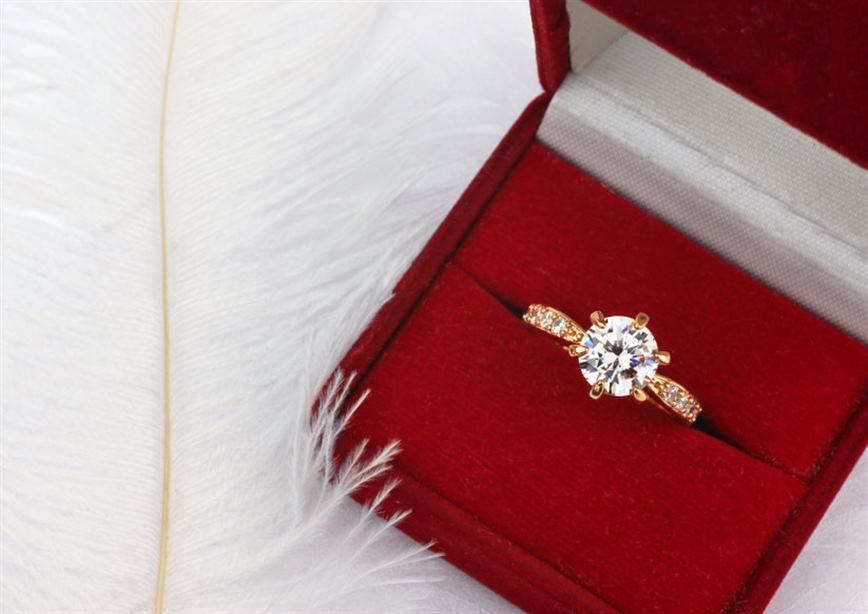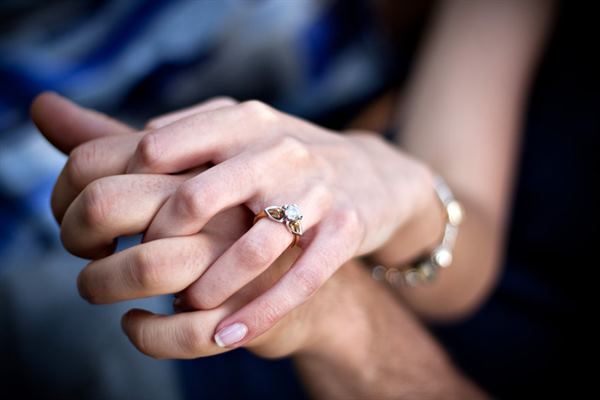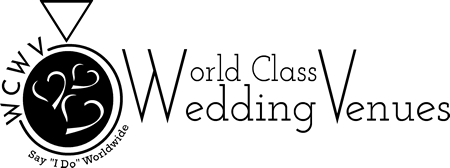Complete Guide to Customizing a Wedding or Engagement Ring

Let’s be real. The last thing your bride-to-be wants is an engagement ring that looks like all the rest.
If you want to sweep your girl off of her feet, you’ll want to design a custom engagement ring that holds special and unique meaning for her.
From the gemstone to the setting, there’s a lot to consider. We know how stressful it can be to design your own ring. We’ve written a comprehensive guide to help you through the process.
Let’s dive in!
1. Identify your stone(s).
Although most couples choose a diamond center stone, diamonds certainly aren’t your only engagement ring option. We’re hearing stories from more and more couples who have personalized rings with their birthstones front and center.
If birthstones aren’t your thing, does your special lady have a favorite gem? Or would she like the idea of incorporating a particular color stone into the ring?
And don’t forget the side stones. Whether you arrange gems around the metal band, place them around the main stone, or incorporate them into the wedding band, there are countless ways to decorate your ring with side stones to tell your personal story.
~
2. Choose the perfect stone cut.
For many brides, finding the right cut is the most crucial step of designing the perfect engagement ring.
So, what styles can you choose from?
Round: It’s a classic! The flawless, round shape allows the stone to reflect more light, giving it a stunning, deep sparkle effect.
Princess: A traditional square cut, the princess cut is timeless and fits any style.
Cushion: Sometimes compared to a pillow, the cushion cut boasts a square cut with rounded corners — a sort of cross between the round and princess cut. It’s one of the most versatile stone cuts for any engagement ring design.
Oval: A sophisticated cut that portrays royalty, power, and beauty, the oval cut is best used for larger stones like rubies and sapphires.
Pear-Shaped: Sometimes referred to as the teardrop, this cut finds its origins in the 1400s. It’s perfect for vintage-inspired brides who appreciate a little extravagance.
Marquise: Also called the Navette cut, this cut takes an elegant “football” shape. The long, narrow stone creates a stunning sparkle and a graceful look.
Emerald: A rectangular stone cut, this style was popular in the 1920s Art Deco period. It’s not too flashy, but instead offers a “hall-of-mirrors” effect.
Baguette: Similar to the emerald cut, the baguette style boasts a rectangular shape and 14 facets. This cut is a great option for accent diamonds.
Radiant: Want a rectangular cut with a little extra sparkle? The radiant cut is exactly what you’re looking for. Plus, with 8 corners rather than 4, it’s less likely to chip.
Asscher: This cut first became popular in the fashion world when Carrie Bradshaw modeled it in Sex in the City. With an octagonal shape, it has a uniquely symmetrical geometry and requires a high-quality diamond.
Heart: Calling all hopeless romantics? The heart cut is the perfect way for you to communicate your deep love. However, it is a complicated cut and will cost you more money.
Trillion: This triangle stone cut comes from the Netherlands and is a wonderful option for couples seeking something alternative or unique. Plus, the shallow cut makes the stone appear larger than it is.

3. Think about the metal.
Okay, so you’ve decided on your stone and your cut.
How about the rest of the ring?
The metal color and style should complement your chosen gemstone(s). The wrong color metal might look funky alongside a certain color stone. And the wrong band style might fit awkwardly with the main stone.
First, let’s address color. Yellow gold remains the most popular engagement ring color. However, many brides prefer white metal options (like platinum and white gold). Does your bride-to-be wear more gold or silver jewelry? It’s important to base this decision on her personal style.
If your bride has more alternative taste, rose gold and two-tone (white gold and yellow gold) engagement rings offer a unique, aesthetic design that may better fit her personality.
If you choose a colorful gem for your center stone, it’s probably best to stick with basic yellow or white gold metal, as rose gold or two-tone metal may create an unnatural contrast with certain stone colors.
Furthermore, there are countless band — or shank — styles you can consider — from embedding the shank with side stones, using a curved shank, or incorporating a specific design into the shank and setting. The sky's the limit here…that is, with a skilled jeweler on your side.
~
4. Pick your stone setting.
The stone setting — how a stone is attached to the shank — is nearly as important as the stone cut. From the classic prong setting to alternative tension settings, there are many options to choose from.
Prong: The most common type of setting, the prongs cradle the stone and bring it into focus. The simple setting is most frequently used for single-stone rings — or solitaire rings. You have your choice between a 4-prong or 6-prong setting. While 6 prongs create a rounder look and are slightly more secure, they can overwhelm smaller stones.
Basket: This setting includes prongs AND a styled basket that secures the stone and reduces risk of stone chipping.
Halo: In recent years, the halo setting has emerged as a popular engagement ring style. With a large center stone surrounded by an arrangement of accent stones, the main stone appears larger and grander than its carat weight.
Pavé: Want to give your bride an engagement ring with some extra sparkle? Try a pavé setting. The main stone sits atop a platform and shank embedded with more tiny stones. Your bride will love it!
Cathedral: The architectural cathedral setting connects the shank and the center stone with sweeping arcs, giving it a grand, elegant look.
Bezel: Looking for a sleek ring design? The bezel setting is for you. Holding the center stone entirely or partially with a metal rim, these rings look modern and slick.
Tension: With a uniquely modern design, the shank creates pressure that secures the center stone in place, making the gem appear as if it’s floating.
Bar: Smooth and contemporary, stones are held in place between a series of vertical bars attached to the shank.
Gypsy: A simplistic ring style that looks more metal than stone, the gypsy setting includes stones “flush” inside the metal shank so they don’t protrude outside the ring. Smooth and VERY secure, this style gives major boho vibes.
Tiffany: In 1886, Tiffany & Co. designed this 6-prong setting that uniquely displays a diamond’s sparkle with higher-set prongs. Unfortunately, you can only find this style at Tiffany & Co. stores.
Channel: Providing ultimate security for smaller stones, the channel setting holds a row of stones between two metal bands, or channels. This style is great for wedding bands.
~
5. Design a ring that tells YOUR story.
At the end of the day, your engagement ring should tell your unique relationship story.
But how can you make it personal?
Here are a few suggestions:
Depict your union: Use a toi-et-moi ring style with both of your birthstones or an interwoven shank style to represent the beginning of your forever union.
Engrave a personal message: On the inside of the band, engrave something meaningful — from your wedding date, to your partner’s name or initials, to a significant quote or phrase.
Remember the family: Coming into marriage with children? Incorporate gemstones on the ring to represent the kiddos.
Commemorate a meaningful place: Find stones native to your home state or a place that holds special significance for you as a couple. Use that gem as your center stone or side stones.
Take inspiration from her favorite flower: Does your bride favor roses? Orchids? Lilies? Design a shank and setting that are sculpted to represent a flower she loves.
Incorporate heritage: Do you have a symbol-heavy heritage? From an Irish trinity knot to a meaningful Chinese character, implement a little personal history.
Symbolize your faith: Embed the ring with important religious symbols, like a saint, cross, or engraved Bible verse.
Feature interests & passions: Does your bride-to-be love nature? Choose a leafy ring design. Or horses? How about a horseshoe. Or music? Try some music notes or symbols.
~
We hope our guide has given you a good start on your engagement ring-designing process. World Class Wedding Venues offers a wide variety of additional
wedding and engagement tips
.
About to propose?
We’d love to hear your engagement story
! Enter our
engagement story contest
for a chance to win a prize and a feature spot on our website.
Need some help finding a stunning wedding venue? Our
wedding venue finder
is just what you need!
